What is Supply and Demand?
The concept of supply and demand applies to many businesses and industries, and the foreign exchange market is no exception. The lack of supply of an item would naturally bring the demand of said item higher. On the other hand, the excessive supply of an item would result in the lack of demand for the item. This see-saw relationship between supply and demand was written by Philosopher John Locke in his 1691 publication “Some Considerations of the Consequence of the Lowering of Interest and the Raising of the Value of Money” [1].
A real-world example would be the recent prices of gas. As of 26 August 2022, gas prices in the European region rose to ten times the average level. This can be heavily credited to the Russia-Ukraine war which led to a reduction in supply of oil, leading to higher demand and therefore, higher prices [2].
What is Supply and Demand in Forex?
The relationship between supply and demand falls neatly into currencies as well. Investors often use technical and fundamental analysis to determine which currency will rise in value. Understanding the dynamics of supply and demand will help a trader be better equipped to understand current price action and future price movement in the foreign exchange market.
Interested in trading Forex? Open a live trading account with Vantage today and embark on your trading journey.
How to Identify Supply and Demand Zones?
Supply and demand zones encompass a similar idea to the concept of support and resistance. Supply zones work in the same vein as resistance, and demand zones as support. This also equates to the idea of selling at supply zones and buying at demand zones.
To identify supply and demand zones, one must first understand basic market structure. There are two general ways a market can move; a reversal or a continuation. A reversal encompasses Rally-Consolidation-Drop or Drop-Consolidation-Drop structure. While a continuation covers Rally-Consolidation Rally or Drop-Consolidation-Drop [3].
| Market Movement | Name | Graph Pattern |
| Reversal | Rally-Consolidation-Drop (RCD) | |
| Reversal | Drop-Consolidation-Rally (DCR) | |
| Continuation | Rally-Continuation-Rally (RCR) | |
| Continuation | Drop-Continuation-Drop (DCD) | |
The common denominator between all four market structures is the presence of a consolidation. These consolidations are important because they serve as either supply or demand zones that traders can use.
To gain more insight into market structure, check out our Trend Analysis Complete Guide at the Vantage Academy. Additionally, explore our range of free webinars to further expand your knowledge and stay up to date with the latest market trends.
How to Draw Supply and Demand Zones
How to Draw Supply Zones
To draw a supply zone, one must first identify the market conditions they are in. As mentioned above, a trader would want to sell at a supply zone. Supply zones can be found at RCD and DCD market structures and are drawn from the highest wick to the lowest candle body within the consolidation [4].
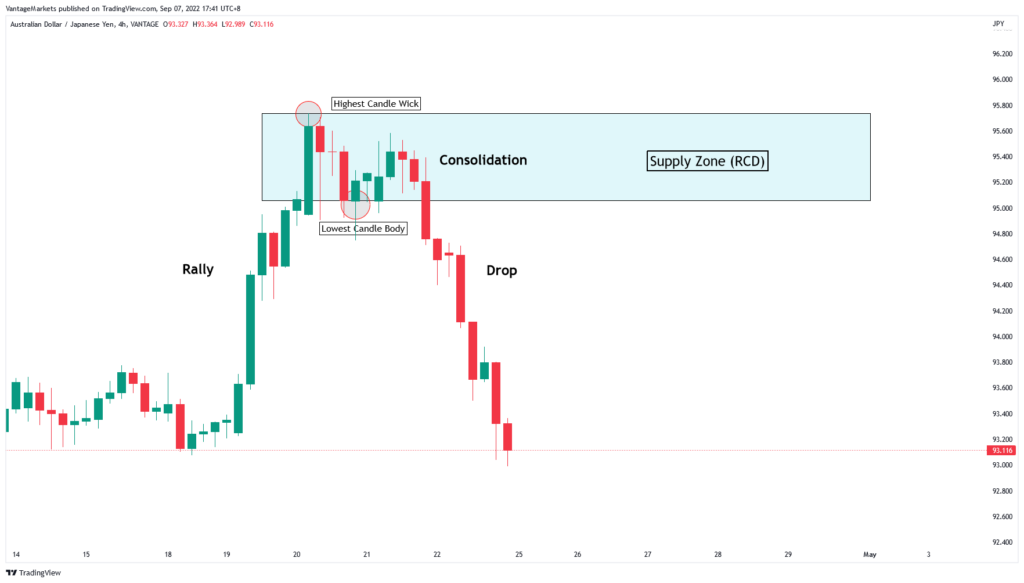
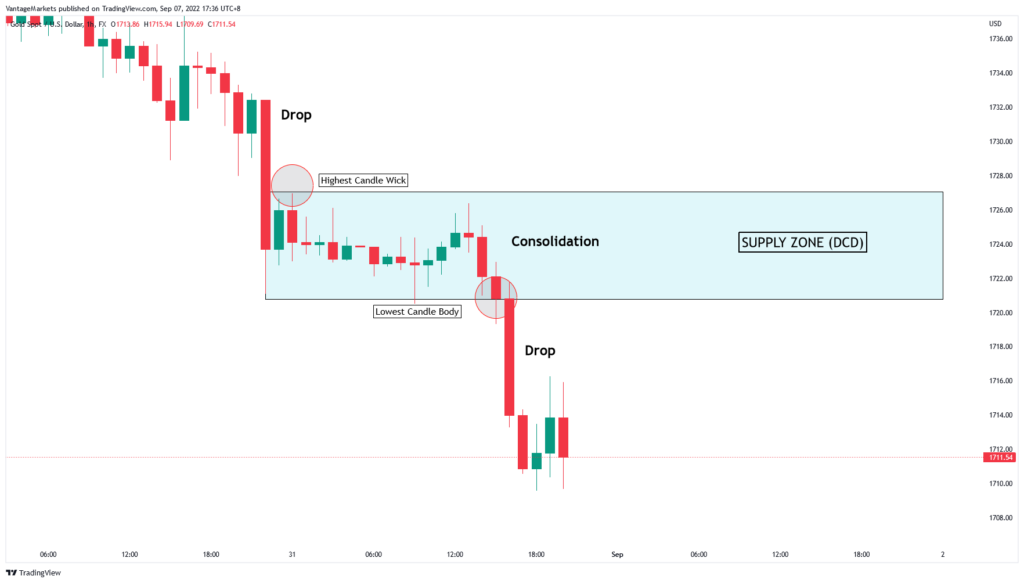
How to Draw Demand Zones
Demand zones are used for buyers in bullish market conditions. Demand zones can be found at DCR and RCR market structures and are drawn from the lowest candle wick to the highest candle body within the consolidation [4].
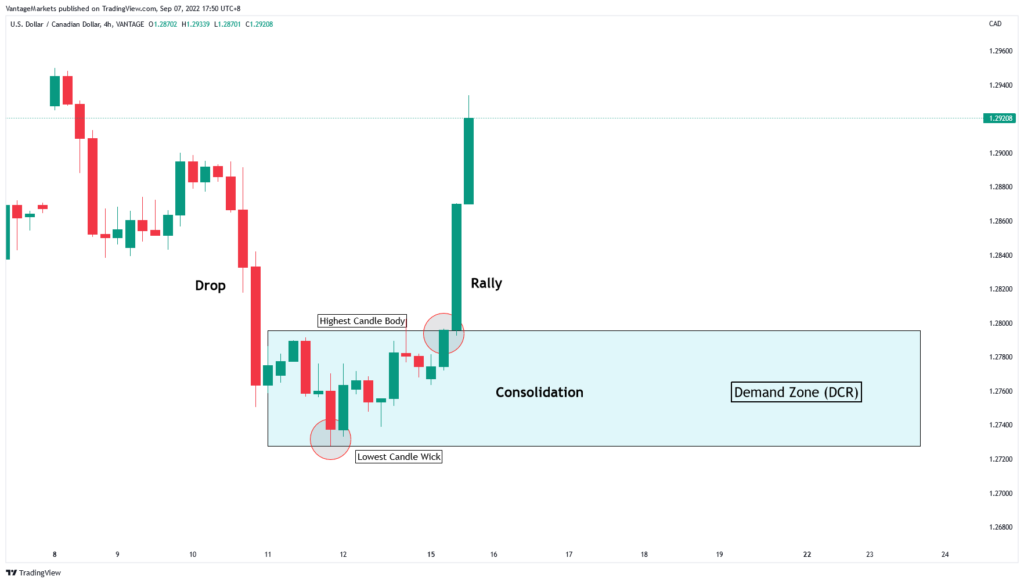
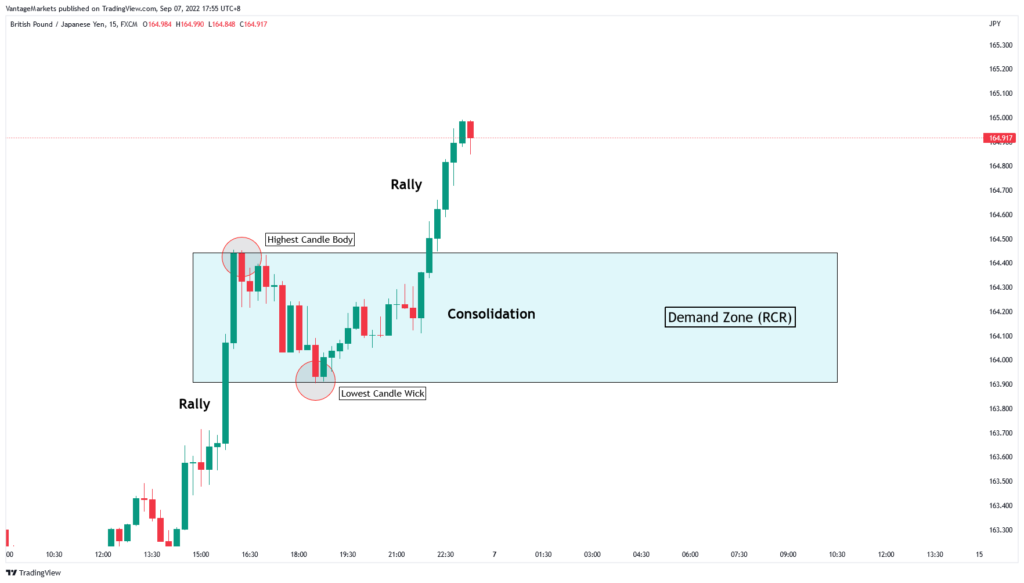
Are you eager to put your knowledge of drawing supply and demand zones to the test? Open a live account with Vantage today and apply your newfound skills to start trading confidently.
Laws/Rules of Supply and Demand
When looking at a chart, there are many consolidation areas but what makes a zone reliable? It is based on three pointers, essentially the laws of supply and demand zones [5].
#1 Time
When talking about time, what it means specifically is time the market spent within the consolidation. The longer the consolidation, the more credibility a zone has. Figures 5 and 6 are examples of demand zones and the duration the market spends within the consolidation.
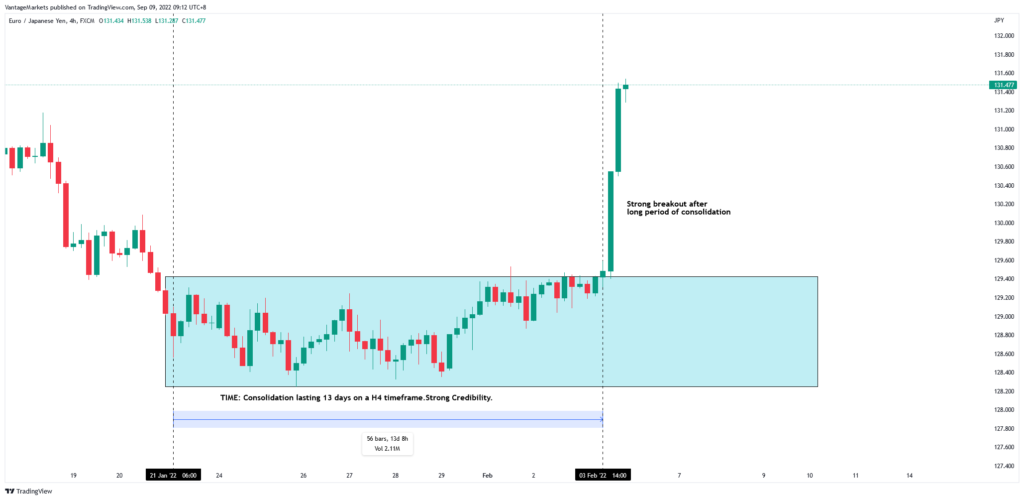
In figure 5, the consolidation lasted 13 days on the H4 time frame with a strong bullish breakout after.
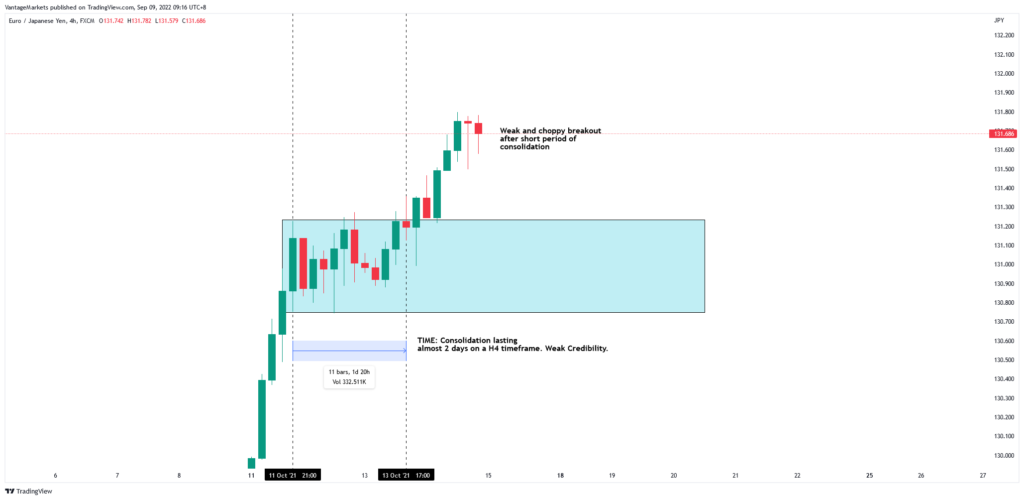
As compared to figure 6, whose consolidation only lasted for approximately 2 days. The breakout that followed was choppy.
#2 Strength
When it comes to strength, the focus would be the strength of the move after the market has moved away from the consolidation zone. The stronger the move away from the consolidation, the more credibility a zone has.
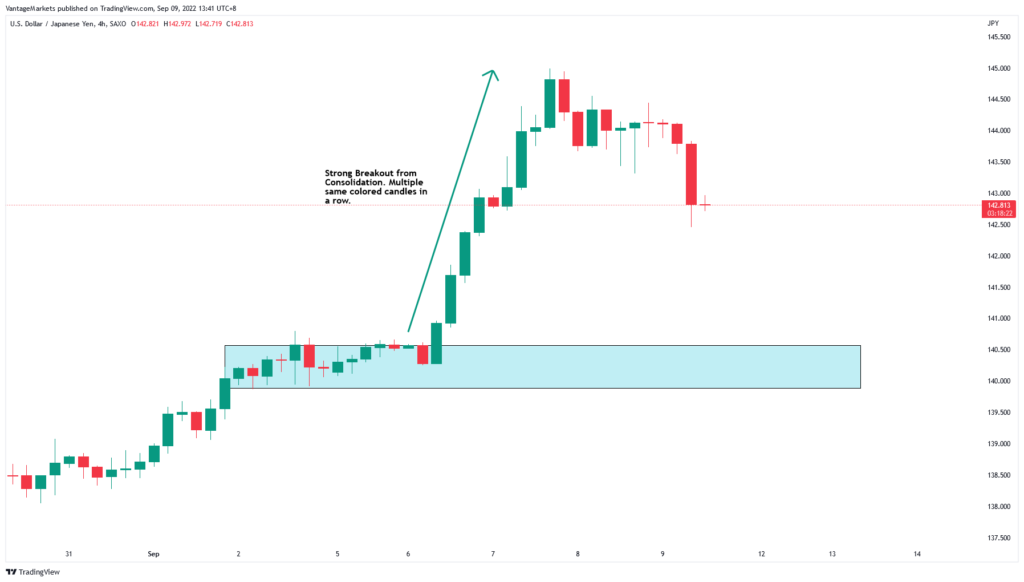
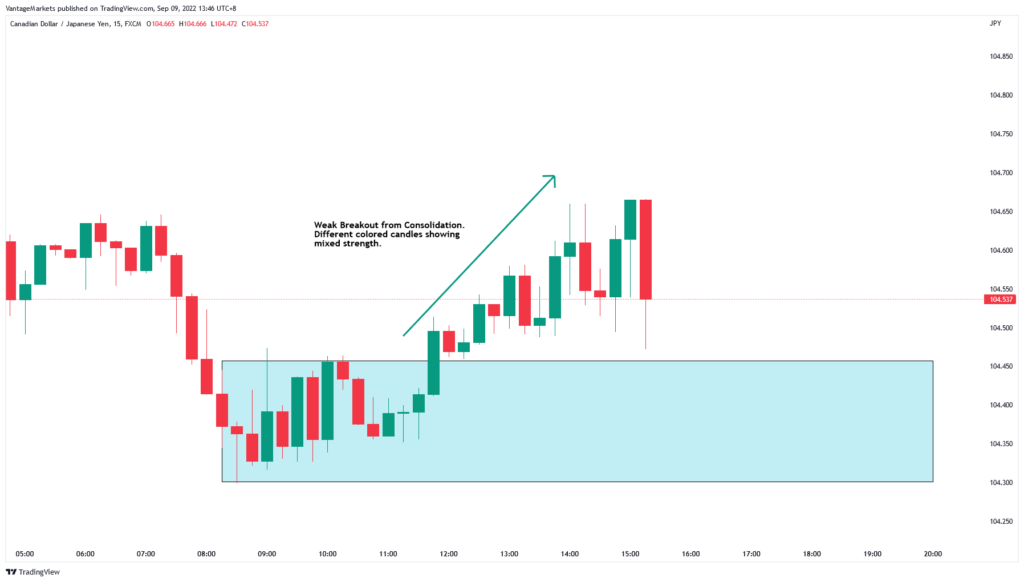
#3 Freshness
Freshness refers to the number of times the zone has been re-tested. In the case of supply and demand, the lesser time the zone has been retested, the stronger the credibility. Note that the concept of freshness is unlike the concepts of support and resistance where the more times the market re-test a certain support/resistance, the stronger it is.
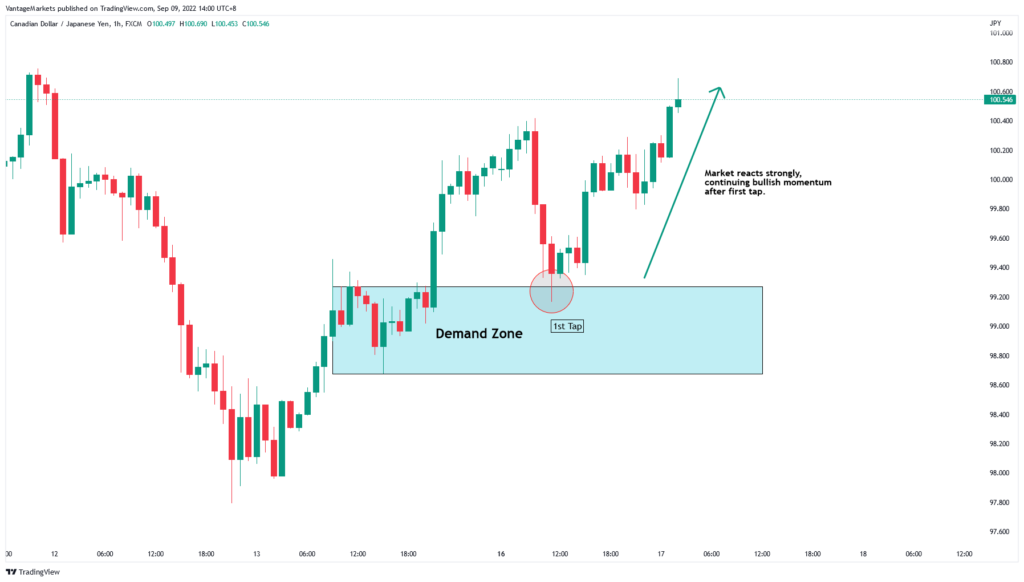
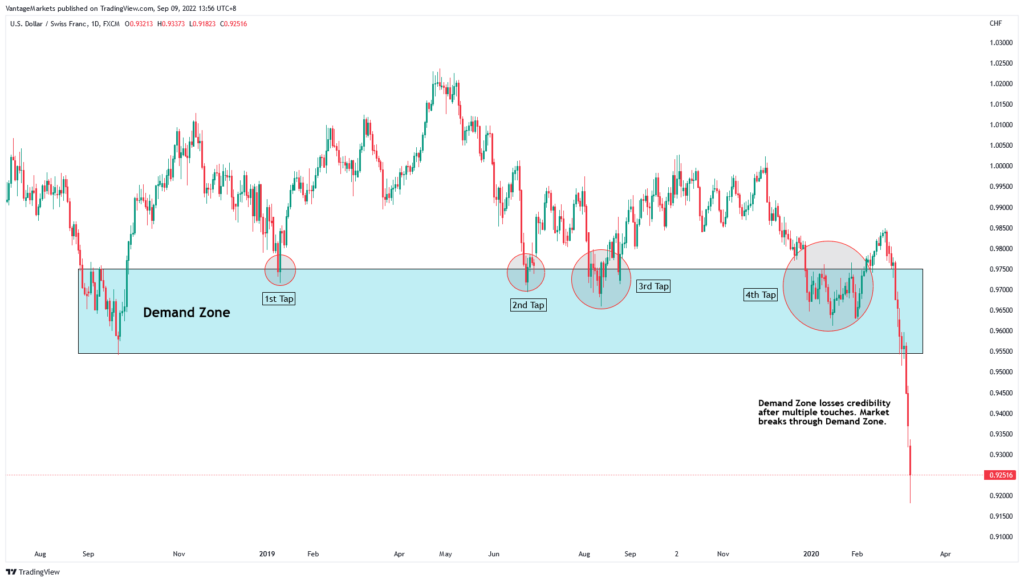
| Time | Strength | Freshness | |
| Strong Credibility | Long periods in consolidation | Strong breakout from consolidation | Market has not retested the zone |
| Weak Credibility | Short periods in consolidation | Weak breakout from consolidation | Markets retested the zone multiple times |
Supply and Demand Trade Examples
Supply Zone Sell Example –
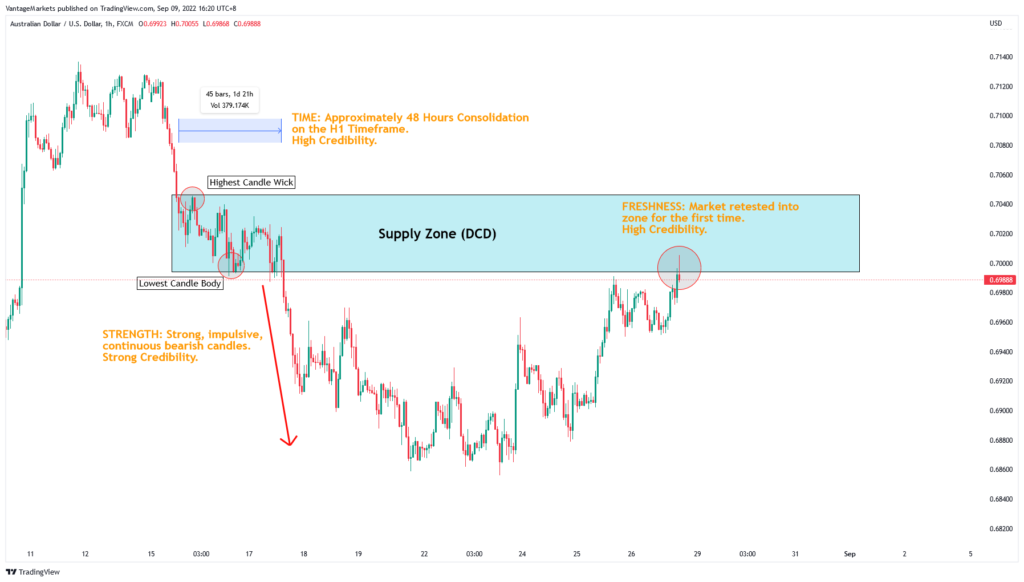
In Figure 11, the chart showcases a sell example. The supply zone denoted in blue fits all three laws of supply and demand. On the H1 chart, the consolidation lasted for approximately 48 hours with a strong bearish move away and it is the first time the market has entered the supply zone.
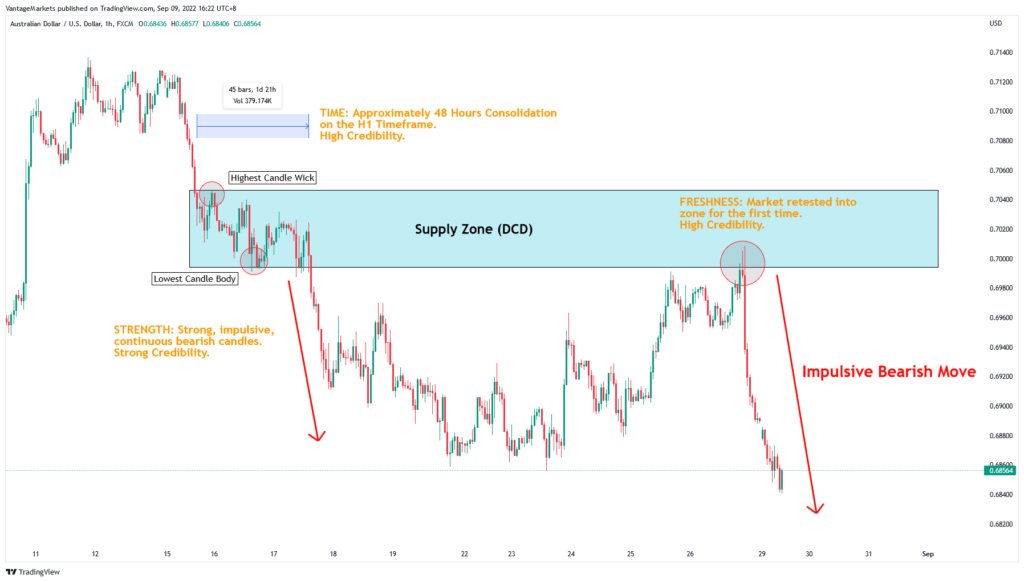
In Figure 12, markets created a new low through the impulsive bearish move after tapping into the supply zone for the first time, further perpetuating the overall bearish trend.
Demand Zone Buy Example –
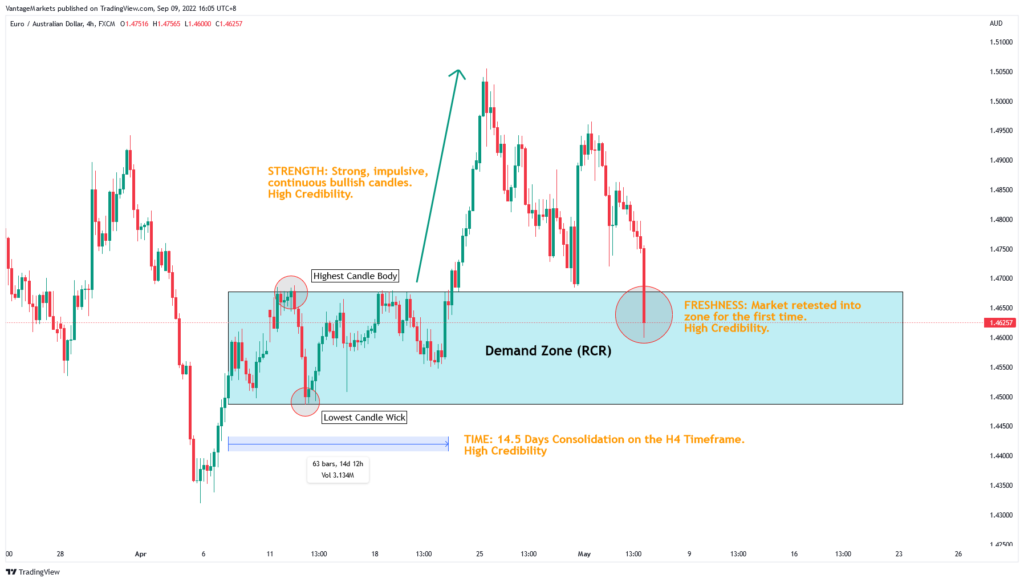
Figure 13 reflects a demand zone with all three criteria in play. On the H4 chart, the consolidation lasted 14.5 days followed by a strong bullish breakout and market is entering the demand zone for the first time.
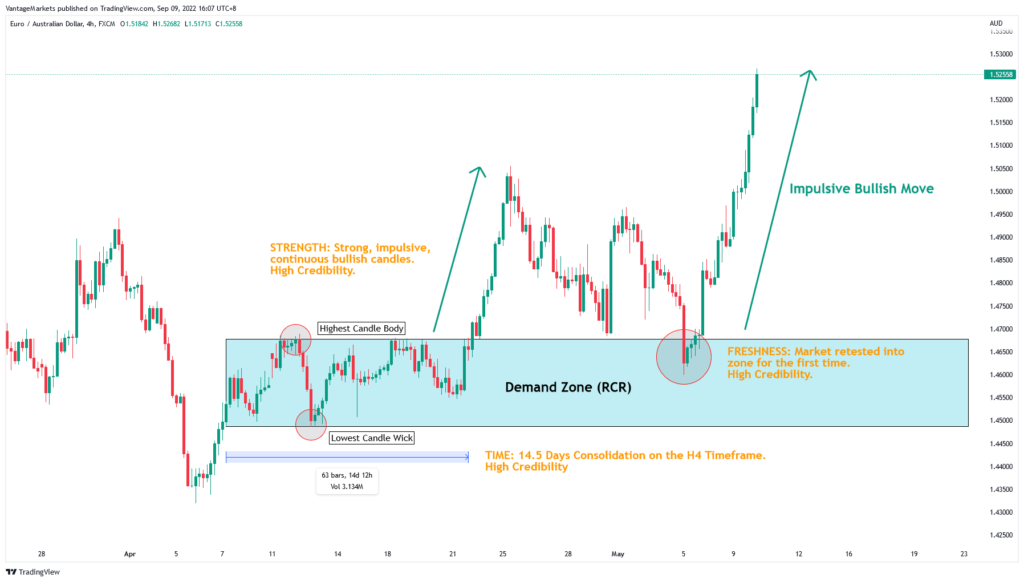
The impulsive bullish move denoted by the green arrow in Figure 14 is a result of all criteria being met.
Supply and Demand Strategy – Tips
#1 Use Long Time Frames
When identifying supply and demand zones, traders often make the mistake of focusing solely on shorter timeframes, such as 1-minute, 5-minute or 15-minute timeframes. It’s essential to understand that looking at longer timeframes such as 4-hr or daily timeframes can provide a clearer perspective on the overall, more macro, trend.
Longer timeframes smoothen out short-term volatility and market noise, allowing traders to identify persistent, significant movements and patterns that are less visible in shorter timeframes. Large entities like institutional traders, banks, and investors frequently use long timeframes to reduce unwarranted volatility.
By looking at the larger picture, traders can make more informed decisions about entry and exit points, set more appropriate stop losses and take profit levels, and better align their trades with the dominant market trend. The key therefore is to make use of both longer and shorter timeframes.
#2 Incorporate Technical Indicators to Confirm Supply and Demand Zones
Make use of technical indicators such as Relative Strength Index (RSI) and Moving Average Convergence/Divergence (MACD) as they can be helpful when the market is moving sideways.
For instance, the RSI can be used to find a potential supply and demand zone reversal. If the RSI suggests the market is overbought or oversold, it may be an indication that the price will soon reverse. If this coincides with a supply or demand zone, it could provide yet another reliable signal to enter or exit a trade.
Read more about the basics of technical analysis here.
#3 Identify Supply and Demand Zones with High Trading Volume
Although identifying supply and demand zones on a price chart is crucial for forex trading, you can supplement this with a volume indicator to determine the strength of these zones. This is where the high buying or selling pressure areas come into play, they are particularly useful as these areas reflect the aggressive interest of traders in certain price levels.
Higher buying pressure often indicates a strong demand zone, where price is likely to bounce upwards due to the presence of many buyers. Conversely, high selling pressure denotes a strong supply zone, where price is likely to fall because many sellers are trying to offload their positions.
You can identify high buying or selling pressure areas by analysing trading volume at specific price levels. For instance, if a demand zone is formed with high volume, it shows that many buyers are willing to buy at that price, which could potentially drive prices higher.
Pros and Cons of Supply and Demand Trading
Just like any trading system, no single one is perfect. It requires constant practise and good trading psychology to be able to use a trading system effectively.
Pros – The laws surrounding supply and demand trading provides trading structure without ambiguity. Being governed by the most fundamental principle in economic theory, its success has withstood the test of time.
Cons – The method of supply and demand trading isn’t a stand-alone trading plan. For its effectiveness to increase, it needs to be use in tandem with other technical analysis tools.
Conclusion
Supply and demand trading can be seen as an advanced form of the concept of support and resistance. While support and resistance are based on singular price points, supply and demand is defined by a price area instead. The laws around supply and demand provide additional scaffolding that limits uncertainty which serves as a huge benefit when it comes to trading. Can’t wait to apply the secrets of supply and demand trading? Try practising it through your own forex demo account.
References
- The Origins of the Law of Supply and Demand. (2021, September 21). Investopedia. Retrieved September 7, 2022, from https://www.investopedia.com/ask/answers/030415/who-discovered-law-supply-and-demand.asp#toc-adam-smith
- Barrett, B. N. (2022, August 26). Why are global gas prices so high? BBC News. https://www.bbc.com/news/explainers-62644537
- Lawler, J. (n.d.). Price Action Trading Strategy: Supply & Demand Zones. Retrieved September 7, 2022, from https://www.flowbank.com/en/research/price-action-trading-strategy-supply-demand-zones
- Dubrov, T. (2022, May 9). Supply and Demand Forex – The Highest Accuracy Method | videos. The5%Ers | Funding Traders & Growth Program. Retrieved September 7, 2022, from https://the5ers.com/supply-and-demand-forex/#Supply_and_Demand_Forex_pros_and_cons
- Supply and demand zones. (2021, May 8). Blog. Retrieved September 21, 2022, from https://www.tradethematrix.net/post/supply-and-demand-basics-in-trading



